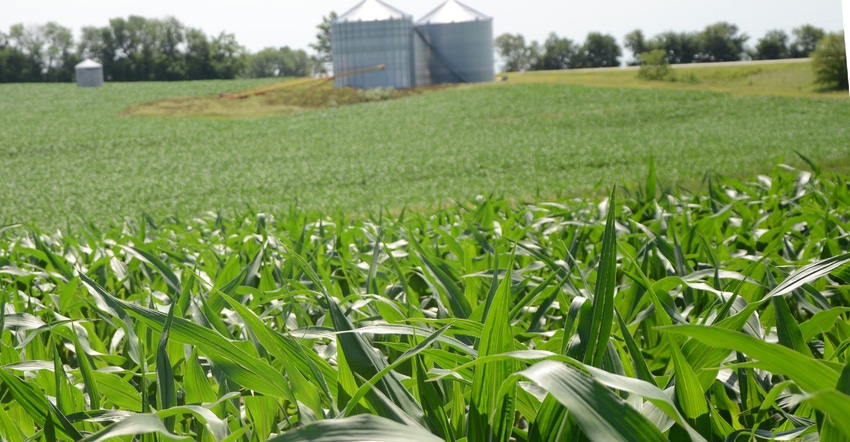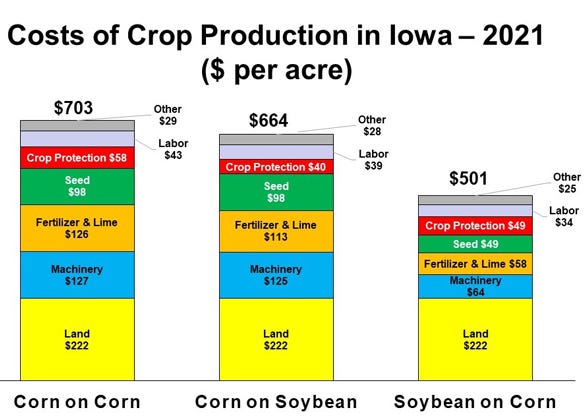January 26, 2021

Corn and soybeans futures prices have recently rallied to their highest levels in years, providing hope for a market-driven profitable 2021 crop year. However, the only certainty about future prices is that they will continue to change until their expiration date, and they could plummet as fast as they rallied. Unless farm operators use futures or options to create a floor for their crop prices, current future prices might foster a false sense of security.
Winter is an opportune time for farm operators to concentrate on calculating their own costs of crop production, not only because they have more control over costs than crop prices, but also because knowing their breakeven prices might ease the struggle to lock in profits before harvesttime. The latest Iowa State University Extension “Estimated Costs of Crop Production” reports cost estimates for Iowa farms in 2021, and provides guidelines to help farmers calculate their own costs of production.
Total costs of corn and soybean production per acre are expected to increase, respectively, by 2.1% to 3.4%, and 2.6% in 2021. However, higher expected corn yields over a 30-year trend for 2021 suggest that on a per bushel basis, costs would increase by 1% to 2.6% to remain below their 2019 marks. Fuel and insecticide costs, interest expenses on preharvest input financing, and crop insurance premiums are projected lower in 2021.

The estimated cost of production for continuous corn is $3.88 per bushel for a target yield of 166, and it goes down to $3.82 for target yields of 184 and 202 bushels per acre. The estimated costs of production per bushel for corn following soybeans are $3.34, $3.31 and $3.32 for target yields of 181, 201 and 221 bushels per acre, respectively.
Cost of production estimates for herbicide-tolerant soybeans amount to $9.16, $8.94 and $8.74 per bushel for target yields of 50, 56 and 62 bushels per acre, respectively. The total cost per bushel of soybeans is projected at $9.04 for non-herbicide-tolerant beans at 56 bushels per acre, according to the report.
The cost estimates are representative of average costs for farms in Iowa. Very large or small farms may have lower or higher fixed costs per acre. The full report is available online through the Ag Decision Maker website.
The publication also includes budgets for alfalfa hay establishment with an oat companion crop and by direct seeding. Annual production costs for established alfalfa or alfalfa-grass hay, as well as a budget for maintaining grass pastures, are included. Actual costs can be entered in the column for “Your estimates,” or by using the electronic spreadsheet Decision Tools.
Breakdown of costs for 2021
For corn, land costs account for about one-third of total costs of production. Values of $187-, $222- and $256-per-acre rent for the low-, medium- and high-quality land, respectively, were assumed. Variable costs represent just over half of the costs of production, and nitrogen and seed costs account for about 43% of the variable costs.

Nitrogen price is projected stable at 34 cents per pound in 2021, but total nitrogen costs are projected to go up by 6% to 11%, reflecting the higher application rates recommended by the ISU Corn Nitrogen Rate Calculator. Corn seed costs are expected to increase by 2% to $262 per bag.
Land costs account for 44% of total costs of soybeans production, and variable costs account for an additional 42%. Seed and fertilizers amount to 44% of variable costs. Phosphorus and potassium were charged, respectively, at 39 and 30 cents per pound. Machinery costs are projected to decline by 6% primarily due to lower diesel costs: $2.02 in 2021 vs. $2.56 in 2020.
Profitability prospects
Uncertainty regarding crop prices is substantial in the coming season. The most recent USDA projections for 2021-22, published in October, put the average U.S. farm prices for corn and soybeans at $3.65 and $10, respectively. In this scenario, production of herbicide-tolerant and non-herbicide-tolerant soybeans would be profitable for all target yields considered in the report. Net returns per acre to herbicide-tolerant soybean production would range from $42 to $78 per acre, depending on target yield and tillage practice.
Corn production would not be profitable in a continuous corn scenario if the price per bushel is $3.65. Net returns to corn following soybeans would range from $55 to $74 per acre under conventional tillage, and average $82 and $75, respectively, under strip tillage and no-till.
Current futures prices seem to indicate that corn and soybean prices might average $4.45 and $11.40 per bushel in 2021-22, respectively. In this optimistic scenario, corn production would generate profits north of $95 per acre in a continuous corn rotation, and above $200 per acre following soybeans. Profits from soybean production would exceed $110 per acre.
However, futures prices are currently reflecting a market reaction to unexpected USDA production and stocks figures, and they could retrench fast once the markets reassess the real impact of the new information. In any case, farm operators can always improve their profitability or limit losses by focusing on managing costs and using their breakeven estimations to implement a tailored marketing plan.
Cost calculations
Knowing costs is key, as it is to understand the assumptions behind the budgets used in their calculations. When using the ISU cost of production estimates for 2021, keep several things in mind. First, fertilizer and lime costs include volume and early purchase discounts. Second, farmers paying land rents higher than the ones projected in the report might face higher costs of production. Operator landowners on fully paid land will have much lower accounting costs, since the cash rent used in the report will only be an opportunity cost and not a cash cost (as it is for tenants).
Reference yields for corn and soybean budgets in the annual ISU report reflect 30-year trend yields. In the latest projections used for the 2021 report, corn yields are 2 bushels higher than for 2020, while soybean yields remained unchanged.
Starting in 2021, the amount of nitrogen applied to corn production follows the recommendations from the ISU Corn Nitrogen Rate Calculator. The projected corn-to-nitrogen price ratio used in the calculator amounted to 12.35. Such methodological adjustment resulted in an average 6% increase in the amount of nitrogen applied to corn following corn, and an 11% increase in the amount applied to corn following soybeans.
Producers must have a strong grasp of their own production costs, and the ISU report provides a step-by-step guide to help them estimate breakeven prices, and serves to benchmark operations and trigger relevant questions on how to better manage enterprise costs.
Plastina is an ISU extension economist.
Source: ISU Extension and Outreach Ag Decision Maker, which is responsible for the information provided and is wholly owned by the source. Informa Business Media and its subsidiaries aren't responsible for any of the content contained in this information asset.
About the Author(s)
You May Also Like




